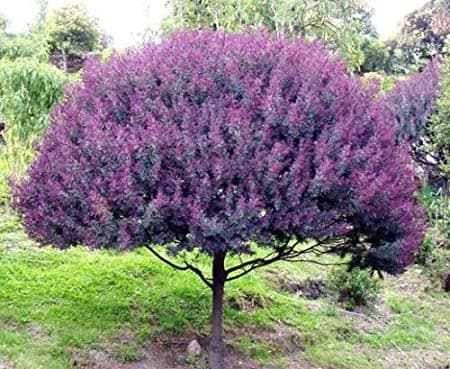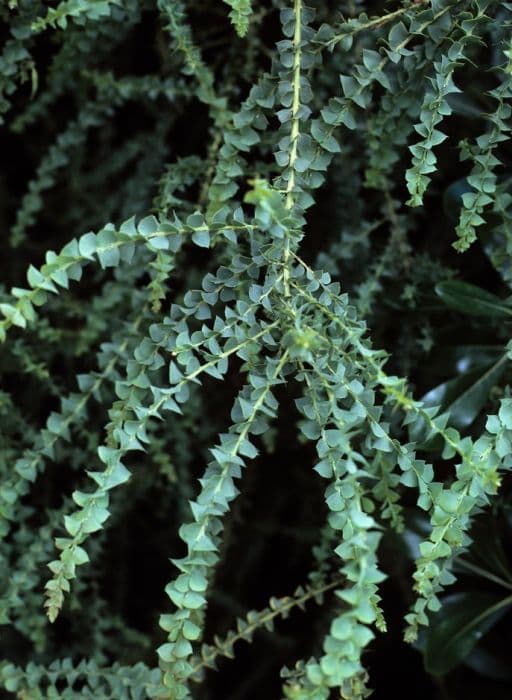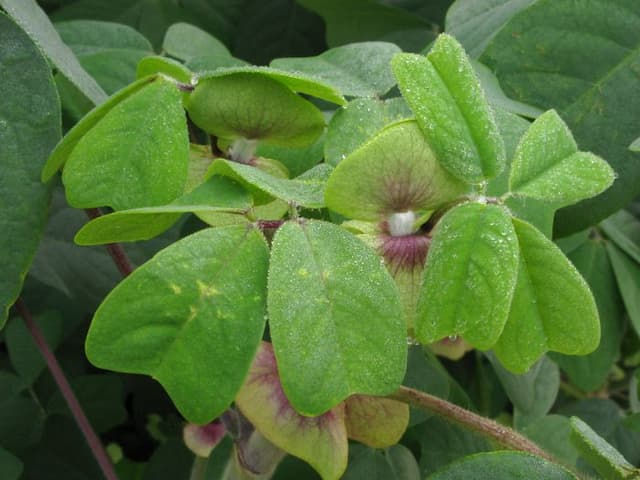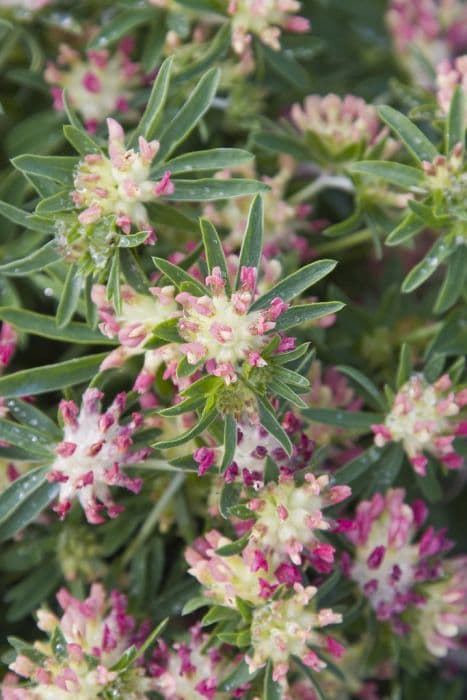Japanese Wisteria Wisteria floribunda 'Lawrence'
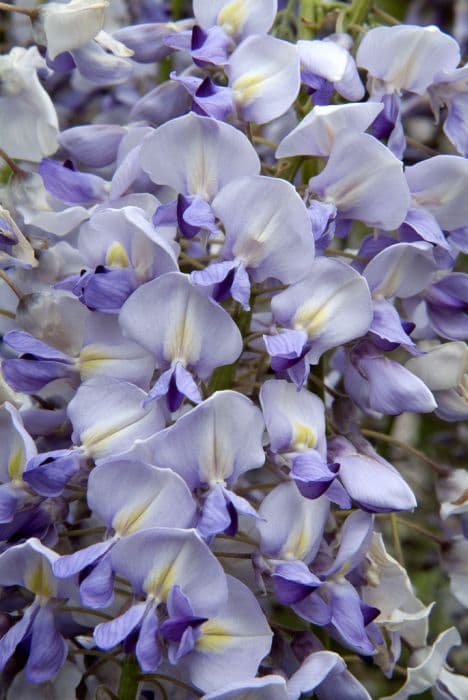
ABOUT
Wisteria floribunda 'Lawrence' is a striking woody climbing plant, known for its cascading clusters of flowers. It displays tightly-packed, long, drooping racemes of beautiful pea-like flowers that can range from a delicate pale blue to a more vibrant purplish-blue color. These graceful flower clusters hang elegantly off the plant and can create a dramatic floral display during its blooming period in spring. The leaves of Wisteria floribunda 'Lawrence' are pinnately compound, meaning that they are composed of multiple leaflets arranged on either side of a common axis. They are a vibrant green color, which contrasts beautifully with the blooms and provides a lush backdrop throughout the growing season. The leaflets themselves have a smooth texture and are oval-shaped with a pointy tip, giving the foliage an overall delicate and feather-like appearance. The twining stems of the plant are another key attribute, enabling it to climb trellises, arbors, or other support structures, making it an excellent choice for vertical gardening. The bark on older stems becomes rugged and gnarly, adding character to the plant even when it is not in bloom. In the autumn, the leaves may turn a yellow color before dropping, signaling the end of the growing season. Overall, the appearance of Wisteria floribunda 'Lawrence' is one of an enchanting and romantic plant, bringing a sense of elegance and old-world charm to any garden setting with its pendulous florals and verdant foliage.
About this plant
 Names
NamesSynonyms
Japanese Wisteria, Lawrence Wisteria
Common names
Wisteria floribunda 'Lawrence'.
 Toxicity
ToxicityTo humans
Japanese wisteria, including the variety 'Lawrence', is toxic to humans if ingested. All parts of the plant contain toxic substances known as glycosides, with the seeds and pods being particularly poisonous. If someone eats parts of this plant, they may experience symptoms such as nausea, vomiting, diarrhea, and stomach pain. In severe cases, it can lead to dizziness, confusion, and even collapse. It is important to seek medical attention if ingestion is suspected.
To pets
Japanese wisteria is also toxic to pets, including dogs and cats. The seeds and pods contain the highest concentration of toxic glycosides which can cause similar symptoms in animals as in humans if ingested. Symptoms of poisoning in pets may include vomiting, diarrhea, depression, and in some cases, seizures. It is essential to contact a veterinarian immediately if a pet consumes any part of the wisteria plant.
 Characteristics
CharacteristicsLife cycle
Perennials
Foliage type
Deciduous
Color of leaves
Green
Flower color
Violet
Height
20-30 feet (6-9 meters)
Spread
10-30 feet (3-9 meters)
Plant type
Climber
Hardiness zones
5-9
Native area
Japan
Benefits
 General Benefits
General Benefits- Aesthetic appeal: Wisteria floribunda 'Lawrence', commonly known as Japanese wisteria, is known for its stunning cascades of purple flowers, which add a dramatic and beautiful display to any garden.
- Shade provision: When grown over pergolas or trellises, Japanese wisteria provides a natural canopy that can offer shade and a cool area during warmer months.
- Habitat for wildlife: Japanese wisteria can provide a habitat and food source for a variety of birds and insects, including pollinators such as bees and butterflies.
- Privacy screen: When grown along fences or walls, Japanese wisteria can create a dense screen, offering privacy for the garden space.
- Landscaping versatility: It can be trained to grow in various forms, such as climbing vines or standalone trees, making it a versatile choice for many landscape designs.
- Year-round interest: Japanese wisteria provides visual interest throughout the seasons, with its flowers in spring, leafy presence in summer, and interesting branch patterns in winter after the leaves have fallen.
 Medical Properties
Medical PropertiesThis plant is not used for medical purposes.
 Air-purifying Qualities
Air-purifying QualitiesThis plant is not specifically known for air purifying qualities.
 Other Uses
Other Uses- Wisteria floribunda 'Lawrence' vines can be trained to form living tunnels or arches, creating enchanting walkways in gardens and parks.
- The woody stems of mature wisteria can be used in furniture making, where they are valued for their durability and unique appearance.
- In textile arts, wisteria bark can be processed to produce a fibrous material suitable for weaving into fabric or making paper.
- The long, sturdy vines of wisteria can be used in basketry, providing a natural and rustic material for woven crafts.
- During grand blooming events, the flowers of the wisteria may serve as a backdrop for outdoor photography sessions, offering a lush and vibrant setting.
- The plant's vigorous growth habit can be harnessed for competition in wisteria growing contests, focusing on the largest or longest racemes.
- In landscape design, wisteria is often used to camouflage unsightly structures, such as sheds or fences, by allowing it to climb and cover them with foliage.
- Wisteria can be cultivated for bonsai, with skilled gardeners creating miniature landscapes that mimic the appearance of ancient, gnarled trees.
- Floribunda wisteria petals can be used to create natural dyes for textiles, giving fabrics a soft purple or lilac color.
- Some artists use the distinct twisting patterns of wisteria vines as inspiration for sculptures and other forms of visual art.
Interesting Facts
 Feng Shui
Feng ShuiWisteria is not used in Feng Shui practice.
 Zodiac Sign Compitability
Zodiac Sign CompitabilityWisteria is not used in astrology practice.
 Plant Symbolism
Plant Symbolism- Persistence and Longevity: Wisteria plants are known for their ability to live a long time and grow vigorously, symbolizing endurance and the ability to withstand challenges over time.
- Intelligence: In some cultures, Wisteria represents wisdom and scholarly pursuits, as its intricate and expansive growth can be seen as a metaphor for expanding knowledge.
- Welcoming: Wisteria is often planted near the entrance of a home as a way of welcoming guests, suggesting hospitality and friendliness.
- Romance and Passion: With its beautiful, cascading flowers, Wisteria can also be a symbol of love and sensuality, representing the passionate side of nature.
- Good Fortune and New Beginnings: In East Asian cultures, Wisteria is a common symbol in art and is often associated with good luck and the start of new ventures or phases in life.
 Water
WaterJapanese Wisteria should be watered deeply once a week, allowing the soil to dry out slightly between waterings. During hot, dry periods, increase watering to twice a week. Each watering session should provide the plant with approximately one to two gallons of water, depending on the size and maturity of the plant. Ensure that the water penetrates deeply into the soil to encourage a strong, deep root system. Consistent watering is particularly crucial during the first few years of growth to establish the plant well.
 Light
LightJapanese Wisteria thrives best in full sun, needing at least six hours of direct sunlight each day. The ideal spot for the plant is one where it receives unfiltered, direct sunlight throughout the majority of the day, which promotes vigorous flowering and growth.
 Temperature
TemperatureJapanese Wisteria is hardy and can survive in temperatures as low as 10 degrees Fahrenheit, though frost can damage young growth. Ideally, it prefers a range within 60 to 80 degrees Fahrenheit. Protect the plant from harsh winter winds to prevent damage to the vine.
 Pruning
PruningJapanese Wisteria needs to be pruned twice a year to control its growth and promote flowering. Prune in late winter to prepare the plant for spring growth, cutting back last year's growth to two or three buds. A second pruning should occur in midsummer, after flowering, to tidy the shape and maintain the structure. Regular pruning helps prevent the wisteria from becoming invasive and encourages more prolific blooms in the following season.
 Cleaning
CleaningAs needed
 Soil
SoilJapanese Wisteria, including 'Lawrence', thrives in a fertile, moist but well-draining soil mix with a pH of 6.0 to 7.0. A blend of loamy garden soil, compost, and perlite or coarse sand would provide the ideal structure and nutrients for healthy growth.
 Repotting
RepottingJapanese Wisteria 'Lawrence' should be repotted every 3 to 4 years. It's important to increase the pot size gradually and prune the roots slightly to encourage new growth.
 Humidity & Misting
Humidity & MistingJapanese Wisteria 'Lawrence' does well in average outdoor humidity levels and doesn't require specific humidity conditions for healthy growth. No need to alter natural outdoor humidity for this plant.
 Suitable locations
Suitable locationsIndoor
Ensure bright light, ample space, and strong support for climbing.
Outdoor
Plant in full sun, provide sturdy support, and space for climbing.
Hardiness zone
5-9 USDA
 Life cycle
Life cycleJapanese wisteria 'Lawrence' begins its life cycle with seed germination, which requires a period of stratification to break dormancy. Upon sprouting, the young seedling emerges and starts developing a strong root system and foliage in its juvenile stage. As the vine matures, it enters a vegetative growth phase, characterized by the rapid extension of its twining stems and the development of compound, pinnate leaves. After several years, the plant reaches maturity and begins to produce its characteristic long, pendulous racemes of fragrant flowers, typically in shades of blue to violet, during the spring season. Following pollination by insects, it sets seed pods that mature over the summer and burst open in the fall or winter to complete the reproductive cycle. The plant continues to grow and can reach great ages, with some specimens living for over a century, continuing to expand and produce flowers annually.
 Propogation
PropogationPropogation time
Spring-Early Summer
Propogation: The popular method for propagating Wisteria, also known as Japanese wisteria, involves taking softwood cuttings in late spring or early summer. To do this, choose a healthy, new growth shoot and cut a 4 to 6-inch (10 to 15 cm) section just below a leaf node. Remove the leaves from the lower half of the cutting, and dip the cut end into rooting hormone powder to encourage root development. Then, plant the cutting in a pot filled with a mix of half peat and half perlite or sand to ensure good drainage, gently firming the soil around the stem. Place the pot in a warm, bright location out of direct sunlight and keep the soil consistently moist. Roots typically develop within a few weeks, after which the new wisteria can be gradually acclimated to outdoor conditions before planting in its final location.
